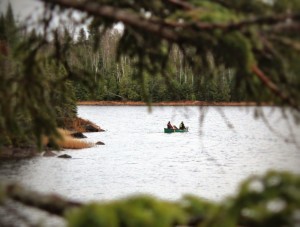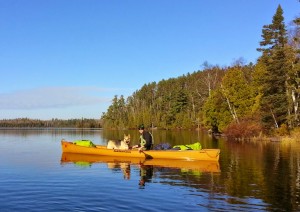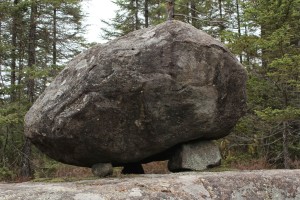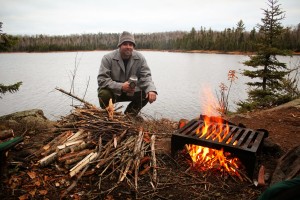
The first time I went to the Boundary Waters in October, an experienced paddler told me before I left, “The thing about October trips is that four out of five days will be raining, but that fifth day will make it all worth it.” A couple weeks later, on the first day of the month, our group paddled a few miles north under blue skies and sunshine, relaxing on a rock in the warm sunset at the end of the day. This was pretty great, but it turned out our first day was our “fifth day.”
The next morning, we woke up to a drizzle that continued more or less the rest of the trip. We covered some 60 miles over six days, crossing lakes big and small, enduring nearly constant cold and wet conditions, and seeing only a couple other parties. Standing around the fire one soggy night on the south shore of Little Saganaga, I felt overwhelmed by the sensation of our camp as a speck of light in a vast, dark land. We might have been the only people on that 1,600-acre lake.
I also remember the next morning, when I drank my coffee while hiding behind a bush from the north wind.
The first week of October is one thing. October 20th is another. But when an old friend arrived home from a summer working in Alaska, eager to go to the Boundary Waters no matter what, and when my wife and I were casting about for an appropriate way to celebrate our 10th wedding anniversary, we packed warm clothes and went.
Northern Minnesota is generally about two weeks ahead of southern Minnesota in the arrival of fall and winter, so I prepared for typical November conditions in my part of the state. It could be 34 degrees and raining. It could be sunny and cool. It could be snowing.
Whatever it was, it would be worth it.

We pushed off from the Sawbill Lake public landing mid-afternoon, with a couple hours of paddling ahead, and a couple hours of daylight. The water was flat, the sun dipped toward the tree tops, and we sliced up the lake to the short portage into the Kelso River.
Not long after we left the portage from Sawbill, I thought I saw a flash across the bog. The only explanation was a paddle blade, and I figured the only way someone would be on the river this late in the day was if they were camped at one of the three sites on the lake, so I was a little disappointed, but I didn’t need to be. We eased up the river, winding along a channel carved through the floating mire. Katie and I were in our Wenonah Spirit II and Ryan and his dog Pondo were in a Mad River Canoe Sunrunner, a sleek Kevlar beauty. At a bend, another solo paddler in a Kevlar canoe slid into view, followed by a pair of people in a green one.
We all stopped paddling and talked as we passed, the length of our conversation dictated by the momentum of our canoes. They were heading back to their campsite on Sawbill – not on Kelso – and mentioned they had seen firewood at one of the sites on this lake. Then Ryan returned a piece of fishing gear to them that he had found on the portage, and we carried on, heading for that site with the firewood waiting.
We were alone on the lake for the next three nights. It was often in the forties and gray, but only rained for a few hours. We burned wood and made food and explored and stared across the lake in awe at the big country in which we were a small circle of civilization.
There is much to enjoy in the Boundary Waters. The sculpted scenery of basalt, bogs, white pine, and water is a feast for the eyes. It sings a song of wind and pine and sometimes such utter silence that you hear the roar of your blood rushing through your ears. You hear wings as a bird flies down the lake and look up and see it a quarter-mile away. There is the physical challenges of paddling and portaging, the rugged, rocky campsites, and the “ignorant and gullible fish” (thank you Sawbill Outfitters). We come for all of it.
For me, the biggest draw of wilderness is the solitude. The absence of people defines the landscape as much as rock, pine, and water, or loons and moose and wolves. Being alone in the complex and indifferent wilderness ecosystem is a necessary reminder of humility. We see our limitations, and feel our innate will to survive. Even if this time of year could be cold and wet, we figured we would find solitude. We cast ourselves out, feeling absorbed by the wild like Jonah swallowed by the whale.
It rained lightly the first morning. We stayed dry and happy with bacon, eggs, coffee, and a tarp. Katie and I worked on the food while Ryan tweaked the tarp until it was flat and taut. It kept the rain off us as bands of showers rolled across the lake all morning, veiling the opposite shore in gray. After it dried up, Katie, Ryan and the dog went off for a paddle around the neighborhood, while I stuck to the site. When they got back, we dove deep into the forest to find wood, and harvested bundles of dry branches from big deadfalls, working up a sweat gathering, cutting and burning the bounty. As it burned, we watched the day go by – more otters (3-4) and loons (1) passed by than people (0).

The next day was our outing. After breakfast, we got into Ryan’s canoe, with all three humans paddling and the dog along for the ride, and headed up the lake and the river, once again winding through boreal bog. Home to pitcher plants and orchids during the warm season, now it was drab but beautiful orange and brown, a thick mat of moss floating over acres. Our day trip had two stops. First we came to the Kelso River Dolmen, a boulder perched on three small rocks, the work of glaciers, Paleoindians, Vikings, or possibly bored CCC workers during the Great Depression. It was impressive and makes me wonder what can be accomplished with muscle, levers, and time. It was also cold and breezy, and we paddled on to the shelter of the woods for our hike.
Normally I wouldn’t be excited about a 460-rod portage (that’s about a mile-and-a-half), but it was just a great walk in the woods when we weren’t carrying our canoe and gear over it. It followed a creek through a bog to a big beaver dam – the headwaters of the Kelso River, which at a total length of four miles, I nominate as the shortest river in Minnesota.
The pond was the center of activity. We saw wolf tracks and scat on the trail not far from it and, as we explored behind the dam, saw moose tracks pressed six inches deep in the mud.
At the far end of the portage we ate lunch overlooking Zenith Lake, on the other side of the Laurentian Divide – we were now in the Arctic Ocean watershed, having come over from the Lake Superior side.
The three-mile round trip kept us warm on a cool afternoon. The paddle back, under sunny skies again but against a slight headwind, also kept the blood moving. Staying active in such conditions is key. The season meant we were able to set up a base camp at a site very near the entry point and experience wonderful solitude, but it also meant we couldn’t exactly lounge around the site. Whenever we had time that wasn’t occupied with cooking, eating, cleaning or other camp chores, we often played a game we dubbed “Chuckers.” It basically involved throwing pieces of wood at other pieces of wood. More importantly, we had to fetch our pieces of wood after chucking them, and it kept us moving.

The wind blew that evening and the next morning, giving voice to the trees.
Our trip out the next afternoon was against a strong south blow. A few whitecaps broke toward us as we paddled down Sawbill Lake, with no choice but to point the bow into the waves and paddle.We got to the landing after a good pull.
Suddenly, there were other people. A couple tourists drove up to the landing, snapped a picture, and drove away. The proprietors of Sawbill Outfitters, Bill and Cindy Hansen, walked down with their dogs to look for some returning day trippers. The solitude slipped away.
The first night we were on Kelso, Ryan and I went out in the canoe after dark to get water. The sky covered in clouds, it was nearly pitch black. He sat in the bow filling bottles and bladders, while I used a total of about 10 paddle strokes to get us out and back on the flat water. We rocked gently in the abyss, neither sky nor lake visible, just our fire perched on the rock above like a lighthouse. Ryan surmised we were probably closer to a moose or a wolf than we were to another person.

